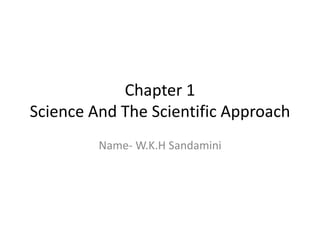
Science and The Scientific Approach
- 1. Chapter 1 Science And The Scientific Approach Name- W.K.H Sandamini
- 2. Outline • Science and common sense • Four methods of knowing • Science and it’s functions • The aims of science, scientific explanation • Scientific research: A definition • The scientific approach • Problem- Obstacle-idea • Hypothesis • Reasoning- Deduction • Observation-Test-Experiment
- 3. Science and Common Sense Science Common sense Relationship - Science is the systematic and the controlled extension of the common sense. Feature Science Common sense Conceptual schemes and theoretical functions Scientists use them Laypersons may also use them but does so in loose fashion accepting fanciful explanations of natural and human phenomenon. Theories and hypotheses Scientists test them systematically and empirically Non scientists also test them but in a selective fashion Notion of control Scientists tries to systematically rule out variables that are possible causes of the effects Laypeople seldomly control their explanations of observed phenomena systematically. Preoccupation with relationship Scientists consciously and systematically pursues relationships Layperson’s preoccupation with relationships is loose, unsystematic and uncontrolled. Difference explanations of observed phenomena Carefully rules out “metaphysical explanation” Laypeople are much more concerned with “metaphysical explanation”
- 4. Four Methods of Knowing • Self correcting approach. Predict things and make them available for others to test. • People’s natural inclination towards truth. Mainly stands with agreeing with reason • Method of established belief. If a distinguish person says something is true, it is so. • People hold firmly to the truth. Because they have always known it to be true. Eg- Our country has taken independence on Feb.4th Method of tenacity Method of authority Method of science Method of intuition (The a priori method)
- 5. Objectivity and Theory What is objectivity? • As Pierce said scientific research are more possible and may be impossible being bound to scientist’s personal beliefs, perceptions, biases, values, attitudes and emotions. This is called Objectivity. • Objectivity is actually like an agreement among expert judges on, I. what is observed or II. what is to be done or III. what has been done in a research • A theory helps a scientist to gain greater objectivity. • A theory comes from people or scientists themselves. • As Polanyi points out a theory is “something other than my self”.
- 6. Science and Its Functions 1. White coat- stethoscope-laboratory stereotype- The perception that scientists are serious people who work at laboratories working with complicated equipment and do innumerable experiments. 2. Scientists are brilliant individuals who think, spin complex theories and spend their time in ivory towers aloof from the world and its problems. 3. This stereotype erroneously equates science with engineering and technology . Eg- Building bridges. Scientist’s job is improvements of artifacts and inventions. Scientist is a sort of highly skilled engineer.
- 7. Science and Its Functions • Two broad views of science. 1. Static view- The view that affects most of the laypeople and students. Scientist’s job is to discover innovative things and adding them to the existing available body of information. This is like adding new pages to a book. Considered with present state of knowledge and adding to it on the present set of laws, theories, hypotheses and principles. 2. Dynamic view- Regards science more as an activity. What scientists do. This is more concerned with heuristic view which means present state of knowledge is the base for further theory and research.
- 8. Functions of Science Two distinct views The non scientists think that science is a discipline or activity of improving things. Functions of science- To make discoveries, to learn facts, to advance knowledge to improve things Braithwaite’s view- Functions of science- To establish general laws on the empirical events or objects with which science in question is concerned . This may help us to connect together our knowledge and make reliable predictions of yet unknown events
- 9. Sampson’s Two Opposing Views of Science Conventional/Traditional Perspective Nontraditional /Socio historical Perspective Presents nature without bias or distortion. Goal- To describe with the highest degree of accuracy. How the world really looks like. Sees science as a story. Reality can only be discovered by stories that can be told about it. No bias point is needed to grasp the reality. Need a stand point to discover the reality. Science is designed to reflect things like a mirror. Science gives different accounts of personality and versions of reality. Scientist is considered as a story teller. Methodological considerations may sometimes would weaken the researcher's ability to discover the absolute theory. Social and historical factors affect researcher's understanding of reality.